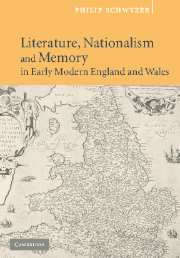Book contents
- Frontmatter
- Contents
- Acknowledgments
- Note on the text
- Introduction: remembering Britain
- 1 Spenser's spark: British blood and British nationalism in the Tudor era
- 2 Bale's books and Aske's abbeys: nostalgia and the aesthetics of nationhood
- 3 “Awake, lovely Wales”: national identity and cultural memory
- 4 Ghosts of a nation: A Mirror For Magistrates and the poetry of spectral complaint
- 5 “I am Welsh, you know”: the nation in Henry V
- 6 “Is this the promised end?” James I, King Lear, and the strange death of Tudor Britain
- Bibliography
- Index
6 - “Is this the promised end?” James I, King Lear, and the strange death of Tudor Britain
Published online by Cambridge University Press: 07 December 2009
- Frontmatter
- Contents
- Acknowledgments
- Note on the text
- Introduction: remembering Britain
- 1 Spenser's spark: British blood and British nationalism in the Tudor era
- 2 Bale's books and Aske's abbeys: nostalgia and the aesthetics of nationhood
- 3 “Awake, lovely Wales”: national identity and cultural memory
- 4 Ghosts of a nation: A Mirror For Magistrates and the poetry of spectral complaint
- 5 “I am Welsh, you know”: the nation in Henry V
- 6 “Is this the promised end?” James I, King Lear, and the strange death of Tudor Britain
- Bibliography
- Index
Summary
From the dawn of the Tudor era, the fortunes of British nationalism had been closely bound up with those of the ruling dynasty. Yet the initial response of many British nationalists to the death of the last Tudor monarch in 1603 was one of euphoria. The succession of the Scottish king James VI to the English throne meant that for the first time in more than a millennium – by some accounts, since the era of Brutus himself – the whole island would be united under a single ruler. Proclaiming his desire to see a perfect union between his kingdoms under “the true and ancient name which God and time have imposed upon this isle, extant and received in histories … and other records of great antiquitie,” James adopted the royal style of “King of Great Britain.” The most hallowed aims of British nationalism seemed on the point of being achieved. Yet within a few years, that distinctively Tudor form of nationalism rooted in the desire to recapture British antiquity would have been almost completely expelled from English politics and literature. An early sign of this rapid decline would be the unanticipated apostasy of the leading nationalist playwright, William Shakespeare.
FIGURES OF UNION
Many of the poets who celebrated James's accession or lauded him in the first years of his reign were keen to associate the new monarch with the triumph of British nationalism.
- Type
- Chapter
- Information
- Publisher: Cambridge University PressPrint publication year: 2004
- 1
- Cited by



